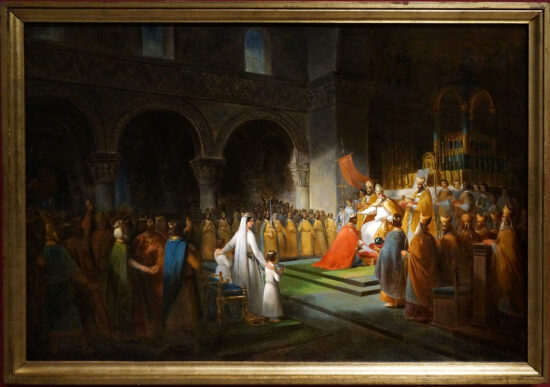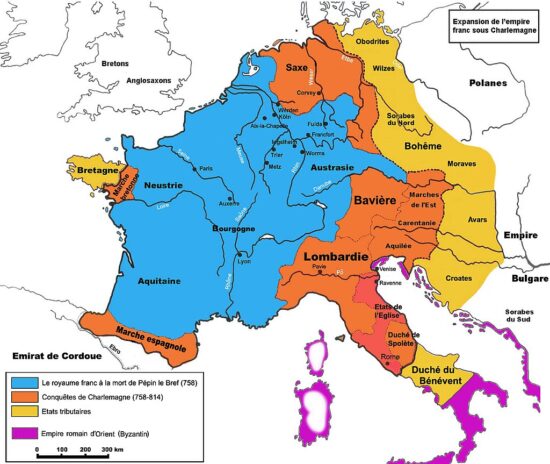Puberty
Less than thirty years after the Lombard conquest the first king of the Carolingian dynasty of the Franks known as Pepin the Short became entangled in Italian matters. Pepin had become king with the support of the last Byzantine Pope Zachary in 751 and had decided to extend his influence and gain a foothold in Italy by helping his successor Stephen II against the Lombards in Italy.
Pope Stephen II traveled to Paris to anoint the Frankish king in an impressive ceremony that became the first recorded crowning of a civil ruler by a pope in history and returns Pepin the Short forced the Lombards to return the former Byzantine lands to the Pope of Rome. The Papal state was thus officially born as an autonomous from the Roman Empire (now based in Constantinople) entity. Bologna would now be considered a part of the Papal lands.


Between 773 and 774 the successor of Pepin the Short on the throne of Frankia, Charlemagne, came down to Italy following the request for help of Pope Adrian I against the last Lombard King Desiderio. The Lombards had not followed their promise to return the lands to the Papal Church, Charlemagne, and conquered the capital of the Lombard kingdom (Pavia).
From then on Charlemagne would call himself “King of the Franks and the Lombards by the Grace of God”, creating a personal union of the two kingdoms. The sovereign kept the Lombard legal system but reorganized the kingdom on the Frankish model. At the same time the Lombard-controlled territories that were south of the Papal States continued as an independent Duchy (Duchy of Benevento), Calabria remained under the Byzantine sphere while Naples started to brake off and become increasingly autonomous. Sicily fell to the Arabs.


In 844 an army with Ludovico II, son of Lothair I comes to Italy sowing death. The Bolognese take refuge in the sacred Etrurian mountains of the Montovolo. The young Ludovico II marched on Rome to depose Sergius II and his army plunders Bologna, treating it as an enemy city. Sergius II had been consecrated in a hurry, without waiting for the consent of Emperor Lothair I who sent his son at the head of an army, to punish the violation of the Roman Constitutio of 824.
The new pope acted with common sense and all was finally resolved peacefully. In June 845 Sergio anointed and crowned Ludovico Regnum Italicum in Rome. At the beginning of the 10th century, Bologna was laid waste once more during the incursions of the Hungarians. It quickly bounced back demographically and economic expansion between the 10th and 11th centuries initially something that led to the opening of two new doors in the walls and then, in the second half of the 12th century, to the construction of a new defensive line of walls.




